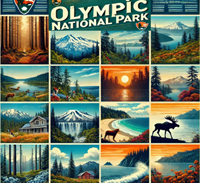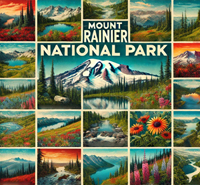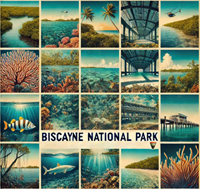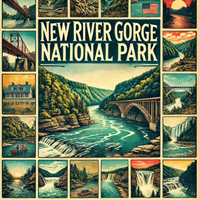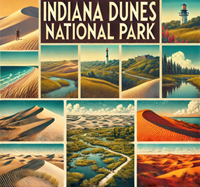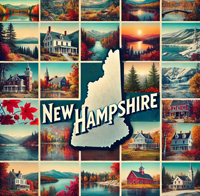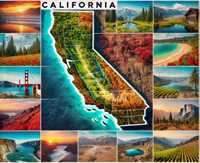
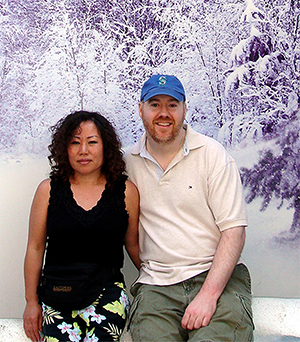
Embark on a journey curated by seasoned explorers William and Hui Cha Stanek, who have spent decades immersing themselves in the diverse landscapes of North America. These itineraries are more than just travel plans - they are thoughtfully crafted adventures designed to help you connect with the natural world, discover hidden gems, and create lasting memories.
National Parks Index | US Itineraries Index | American Roadtrips Index

Bring home a Bugville Critters book and watch as your child's love for reading and learning grows with every page. Hand-painted illustrations bring the heartwarming stories to life. Ask your librarian to add Bugville Critters to the library's digital collection today!
Discover William Stanek's Exclusive Art Collection
Explore and purchase the stunning art featured on this site. Own a piece of William Stanek's unique and captivating artwork today!
(May 2, 2025) Exploring Theodore Roosevelt National Park and Badlands National Park: The Rugged Beauty of the Dakotas
Introduction: A 2-Day Journey Into the Heart of the Badlands
The Dakotas have a way of sneaking up on you. Their beauty isn't as immediate as the towering peaks of the Rockies or the expansive vistas of the Grand Canyon, but it's a beauty that grows on you with every mile traveled, every sunset watched, and every trail explored. Hui Cha and I discovered this when we first ventured into Theodore Roosevelt National Park and Badlands National Park. These parks, with their rugged landscapes and vast, open spaces, have a way of stripping away the noise of the world, leaving you alone with your thoughts and the majesty of nature.
It was a late summer afternoon when we first set eyes on the rolling hills and jagged cliffs of Theodore Roosevelt National Park. The sun hung low in the sky, casting long shadows across the landscape and painting the badlands in shades of gold and amber. We had spent the day driving through the North Unit, marveling at the endless sea of prairie grass that seemed to stretch on forever, only to be interrupted by the occasional rise of a butte or the winding path of the Little Missouri River.
That evening, we set up camp near the river, the sound of the water providing a soothing backdrop as we settled in for the night. As the stars began to appear in the sky – one by one, then by the hundreds – Hui Cha and I sat in silence, our eyes turned upwards, lost in the enormity of the universe. There was something humbling about that moment, something that made us feel small yet profoundly connected to the world around us.
The following days took us deeper into the heart of the Dakotas, to the jagged, otherworldly landscapes of Badlands National Park. Here, the earth seemed to have been sculpted by some ancient, powerful force, leaving behind a land of steep canyons, towering spires, and sharp ridges. The contrast between the two parks was striking – where Theodore Roosevelt was expansive and gentle, the Badlands were intense and dramatic.
But despite their differences, both parks offered a sense of solitude and peace that is increasingly hard to find in today's world. As we explored these rugged landscapes, we found ourselves slowing down, taking in the details, and reconnecting with the natural world in a way that only these kinds of places can offer.
Join us as we take you through the rugged beauty of Theodore Roosevelt National Park and Badlands National Park. We'll share our experiences, tips, and insights to help you discover the magic of these incredible places and to create your own unforgettable memories in the Dakotas.
Day 1: Discovering Theodore Roosevelt National Park
Morning: Sunrise at Oxbow Overlook
Overview
Start your journey in the North Unit of Theodore Roosevelt National Park with a sunrise at Oxbow Overlook. Perched high above the Little Missouri River, this overlook provides a panoramic view of the winding river as it cuts through the rugged badlands. The early morning light transforms the landscape, casting a soft glow over the cliffs and valleys.
Tips from William
"Arrive at Oxbow Overlook by 5:45 AM to set up your camera and find the perfect spot. A wide-angle lens is essential for capturing the expansive view of the river and surrounding badlands. If you have a graduated neutral density filter, use it to balance the exposure between the bright sky and the darker land below."
Insights from Hui Cha
"Even in the summer, mornings in the North Unit can be chilly, so dress in layers. I always bring a small blanket and a thermos of hot tea to stay warm while waiting for the sun to rise. The quiet of the early morning, broken only by the sound of the river below, makes this a perfect place for meditation and reflection."
How to Access Oxbow Overlook
Directions:
- From Watford City, take US-85 south for approximately 15 miles to the entrance of Theodore Roosevelt National Park's North Unit.
- After entering the park, follow the Scenic Drive for about 14 miles to reach Oxbow Overlook.
Overlook Details:
- Location: End of the Scenic Drive in the North Unit
- Elevation Gain: None (overlook is accessible by car)
- Difficulty: Easy
Photography Tips: Position yourself near the edge of the overlook to capture the full curve of the river as it winds through the badlands. Use a tripod to keep your camera steady, especially as the light begins to change rapidly during sunrise. A polarizing filter can help enhance the colors of the sky and reduce glare on the river.
Alternative Activity: If the early start at Oxbow Overlook is too demanding, consider beginning your day with a leisurely walk along the Little Missouri River at the Juniper Campground. The riverside trail offers peaceful views of the water and surrounding landscape, with opportunities for birdwatching and photography.
Mid-Morning: Exploring the Caprock Coulee Trail
Overview
After watching the sunrise, continue your exploration of the North Unit with a hike on the Caprock Coulee Trail. This trail offers a diverse experience, taking you through dense woodland, open prairie, and rugged badlands, with plenty of opportunities to spot wildlife and enjoy scenic views.
Tips from William
"The Caprock Coulee Trail is about 4.4 miles round-trip, with some elevation gain as you ascend to the top of the coulee. Start the hike at the trailhead near the picnic area, and bring plenty of water. A telephoto lens is useful for capturing wildlife, especially deer and bison, which are common along the trail."
Insights from Hui Cha
"Take your time on this hike and enjoy the changing landscapes as you move from one environment to another. The trail can be steep in places, so pace yourself, especially during the ascent. I love stopping at the overlooks along the way to take in the views and catch my breath."
How to Access Caprock Coulee Trail
Directions:
- The trailhead is located near the picnic area, approximately 5 miles from the North Unit entrance on the Scenic Drive.
Trail Details:
- Trail Length: 4.4 miles round-trip
- Elevation Gain: 200 feet
- Difficulty: Moderate
Photography Tips: As you ascend the trail, keep your camera ready for wide-angle shots of the surrounding badlands. The contrast between the green of the prairie and the red and orange hues of the rock formations makes for striking images. Use a polarizing filter to deepen the colors of the sky and enhance the texture of the rocks.
Alternative Activity: If the Caprock Coulee Trail is too challenging, consider hiking the shorter River Bend Overlook Trail, which is only 0.5 miles round-trip with minimal elevation gain. This trail offers stunning views of the Little Missouri River and is a great option for those seeking a less strenuous hike.
Afternoon: Scenic Drive on the South Unit Loop Road
Overview
In the afternoon, drive south to the park's South Unit for a scenic drive on the 36-mile loop road. This drive takes you through some of the park's most iconic landscapes, including the Painted Canyon, Prairie Dog Town, and Wind Canyon. The road is dotted with overlooks and short trails, making it easy to explore the park at your own pace.
Tips from William
"The loop road offers numerous opportunities for photography, so plan to spend several hours exploring. Bring both a wide-angle lens for capturing the expansive landscapes and a telephoto lens for wildlife photography. Stop frequently to take in the views and capture the changing light throughout the afternoon."
Insights from Hui Cha
"This drive is one of my favorite ways to experience the South Unit. Each overlook offers something different, whether it's a sweeping view of the badlands or a close-up look at the park's unique geological formations. I always pack a picnic lunch to enjoy at one of the picnic areas along the route – it's the perfect way to break up the drive and enjoy the scenery."
How to Access the South Unit Loop Road
Directions:
- From Medora, take I-94 to exit 24, and follow the signs to the South Unit entrance.
- After entering the park, follow the loop road, which begins and ends near the entrance.
Route Highlights:
- Painted Canyon Overlook: Located near the visitor center, this overlook provides stunning views of the colorful layers of the badlands.
- Prairie Dog Town: A must-see stop along the loop road, where you can watch these entertaining creatures as they scurry about their burrows.
- Wind Canyon Overlook: Offers breathtaking views of the Little Missouri River as it winds through the canyon.
Photography Tips: At Painted Canyon Overlook, use a wide-angle lens to capture the full scope of the landscape, and consider using a graduated neutral density filter to balance the exposure between the sky and the land. For wildlife shots at Prairie Dog Town, a telephoto lens will help you get close-up images without disturbing the animals.
Alternative Activity: If you prefer a more immersive experience, consider hiking the Wind Canyon Trail, a short 0.5-mile round-trip hike that offers stunning views of the Little Missouri River and the surrounding badlands. The trail is easy and accessible, making it a great option for all ages.
Evening: Sunset at Wind Canyon Overlook
Overview
End your day with a visit to Wind Canyon Overlook, one of the best spots in the park to watch the sunset. As the sun dips below the horizon, the badlands come alive with color, casting long shadows and highlighting the unique formations of the landscape.
Tips from William
"Arrive at Wind Canyon Overlook at least 30 minutes before sunset to set up your camera and find the best angle. Use a tripod to keep your camera steady as the light fades, and experiment with different exposures to capture the changing colors of the sky. A wide-angle lens is ideal for capturing the full scene, but don't forget to zoom in on the details of the canyon as well."
Insights from Hui Cha
"Sunset at Wind Canyon is one of the most peaceful experiences you can have in the park. The wind gently rustling through the canyon, the vibrant colors in the sky, and the feeling of solitude make it a perfect way to end the day. Bring a blanket and a warm drink, and take some time to simply sit and enjoy the moment."
How to Access Wind Canyon Overlook
Directions:
- From the South Unit entrance, follow the loop road for approximately 12 miles to the Wind Canyon Overlook parking area.
Overlook Details:
- Location: Approximately 12 miles along the loop road
- Elevation Gain: None (overlook is accessible by car)
- Difficulty: Easy
Photography Tips: Set up your tripod near the edge of the overlook to capture the sweeping views of the canyon. Use a small aperture (f/16 or smaller) to keep the entire scene in focus, and experiment with different shutter speeds to capture the movement of the wind through the grass. If the sky is clear, consider staying after sunset to photograph the stars as they appear.
Alternative Activity: If you prefer a less crowded spot for sunset, consider visiting Buck Hill, the highest point in the park. The short, steep hike to the top offers 360-degree views of the surrounding badlands, making it a great alternative for those seeking a more solitary experience.
Conclusion: Reflections on the Day
As the last light of day faded from the sky and the stars began to emerge, Hui Cha and I sat in silence at Wind Canyon Overlook, reflecting on the day's journey. Theodore Roosevelt National Park had shown us the quiet beauty of the badlands, a landscape shaped by wind, water, and time. It was a place where you could feel the presence of history, where the past and present seemed to converge in the stillness of the evening.
These moments, spent in the heart of nature, were what made our travels so meaningful. They were a reminder of the power and majesty of the natural world, and of the importance of preserving these wild places for future generations. As we packed up our gear and prepared to head back to camp, I felt a deep sense of gratitude for the day's experiences and for the time spent in this incredible park.
Our journey through the Dakotas was far from over. Tomorrow would take us to the dramatic landscapes of Badlands National Park, where the earth itself seemed to rise up in defiance of the sky, creating a land of sharp ridges, deep canyons, and towering spires. But for now, we were content to sit beneath the stars, enjoying the peace and solitude of the night.
Day 2: The Dramatic Landscapes of Badlands National Park
Morning: Sunrise at Big Badlands Overlook
Overview
Begin your day in Badlands National Park with a sunrise at Big Badlands Overlook, located near the park's eastern entrance. This overlook offers one of the most iconic views in the park, with the rugged badlands stretching out before you, bathed in the soft, golden light of dawn.
Tips from William
"Arrive at Big Badlands Overlook by 5:45 AM to set up your camera and find the best spot. Use a wide-angle lens to capture the vastness of the landscape, and consider using a graduated neutral density filter to balance the exposure between the bright sky and the darker land below. If you have a telephoto lens, use it to zoom in on the details of the rock formations and the layers of color in the cliffs."
Insights from Hui Cha
"Mornings in the Badlands can be chilly, especially in the early hours before the sun rises, so dress in layers. I like to bring a small thermos of coffee and a warm blanket to stay comfortable while waiting for the sunrise. The quiet of the morning, combined with the dramatic scenery, makes this a perfect place for reflection and photography."
How to Access Big Badlands Overlook
Directions:
- From Wall, take I-90 East to exit 131, and follow the signs to the park's eastern entrance.
- After entering the park, the overlook is located just a short drive from the entrance on Badlands Loop Road.
Overlook Details:
- Location: Just inside the park's eastern entrance on Badlands Loop Road
- Elevation Gain: None (overlook is accessible by car)
- Difficulty: Easy
Photography Tips: Position yourself near the edge of the overlook to capture the full scope of the landscape as the sun rises. Use a tripod to keep your camera steady, especially as the light begins to change rapidly during sunrise. Experiment with different shutter speeds to capture the movement of the clouds and the changing colors of the sky.
Alternative Activity: If you prefer a more immersive experience, consider starting your day with a short hike on the Door Trail, located just a few miles from the overlook. This 0.75-mile round-trip hike takes you into the heart of the badlands, offering close-up views of the unique rock formations and an opportunity to explore the rugged terrain.
Mid-Morning: Hiking the Notch Trail
Overview
After watching the sunrise, continue your exploration of Badlands National Park with a hike on the Notch Trail. This popular trail offers a unique experience, taking you through a canyon, up a log ladder, and along a ledge to a viewpoint with stunning views of the White River Valley.
Tips from William
"The Notch Trail is about 1.5 miles round-trip, with some steep sections and a log ladder that adds a bit of adventure to the hike. Start the hike at the trailhead near the Door and Window parking area, and bring plenty of water. A wide-angle lens is useful for capturing the dramatic landscape, but also keep a telephoto lens handy for photographing the details of the rock formations."
Insights from Hui Cha
"The Notch Trail is one of my favorite hikes in the park because of the variety of landscapes you encounter along the way. The log ladder can be a bit intimidating, but it's well worth the climb for the views at the top. Take your time and enjoy the journey – the destination is just as rewarding as the hike itself."
How to Access the Notch Trail
Directions:
- The trailhead is located near the Door and Window parking area, about 5 miles from the eastern entrance on Badlands Loop Road.
Trail Details:
- Trail Length: 1.5 miles round-trip
- Elevation Gain: 125 feet
- Difficulty: Moderate
Photography Tips: As you ascend the log ladder, stop to capture the view from different angles. The changing perspective offers a unique opportunity to photograph the landscape from above. At the top, use a wide-angle lens to capture the sweeping views of the White River Valley, and experiment with different compositions to highlight the contrast between the sharp ridges and the flat plains below.
Alternative Activity: If the Notch Trail is too challenging, consider hiking the shorter Door Trail, which is 0.75 miles round-trip with minimal elevation gain. This trail takes you through a break in the badlands wall, offering close-up views of the rock formations and a chance to explore the rugged terrain without the climb.
Afternoon: Exploring the Badlands Loop Road
Overview
In the afternoon, take a scenic drive along the Badlands Loop Road, which winds through the heart of the park and offers access to some of the most iconic overlooks and trails. This 31-mile road is a must-do activity, with numerous pullouts and short trails that allow you to explore the park at your own pace.
Tips from William
"The Badlands Loop Road offers endless opportunities for photography, so plan to spend several hours exploring. Bring both a wide-angle lens for capturing the expansive landscapes and a telephoto lens for zooming in on the details of the rock formations. Stop frequently to take in the views and capture the changing light throughout the afternoon."
Insights from Hui Cha
"This drive is one of the best ways to experience the diversity of the Badlands. Each overlook offers a different perspective on the landscape, from the colorful layers of the Pinnacles Overlook to the expansive views of the Yellow Mounds Overlook. I always pack a picnic lunch to enjoy at one of the picnic areas along the route – it's a perfect way to break up the drive and take in the scenery."
How to Access the Badlands Loop Road
Directions:
- Start at the park's eastern entrance near Wall, and follow the Badlands Loop Road (SD-240) west through the park.
Route Highlights:
- Pinnacles Overlook: Located near the western end of the loop road, this overlook offers one of the most expansive views in the park.
- Yellow Mounds Overlook: Known for its vibrant, multicolored hills, this overlook is a photographer's dream.
- White River Valley Overlook: Offers sweeping views of the White River Valley and the surrounding badlands.
Photography Tips: At Pinnacles Overlook, use a wide-angle lens to capture the vastness of the landscape, and consider using a graduated neutral density filter to balance the exposure between the sky and the land. At Yellow Mounds Overlook, experiment with different angles and compositions to highlight the contrast between the colorful hills and the surrounding landscape.
Alternative Activity: If you prefer a more immersive experience, consider hiking the Castle Trail, a 10-mile round-trip hike that takes you through some of the most rugged and remote areas of the park. The trail is long but relatively flat, making it a great option for those looking for a more challenging hike. If 10 miles sounds too daunting, you can hike a portion of the trail and still experience the dramatic landscapes of the Badlands.
Evening: Sunset at Panorama Point
Overview
End your day with a visit to Panorama Point, one of the best spots in the park to watch the sunset. As the sun dips below the horizon, the badlands come alive with color, casting long shadows and highlighting the unique formations of the landscape.
Tips from William
"Arrive at Panorama Point at least 30 minutes before sunset to set up your camera and find the best angle. Use a tripod to keep your camera steady as the light fades, and experiment with different exposures to capture the changing colors of the sky. A wide-angle lens is ideal for capturing the full scene, but don't forget to zoom in on the details of the rock formations as well."
Insights from Hui Cha
"Sunset at Panorama Point is one of the most beautiful experiences you can have in the Badlands. The colors of the landscape are so vibrant in the fading light, and there's a sense of peace and reflection that comes with watching the sunset here. Bring a blanket and a warm drink – it can get chilly as the sun goes down."
How to Access Panorama Point
Directions:
- From the eastern entrance, follow the Badlands Loop Road west for approximately 20 miles to the Panorama Point parking area.
Overlook Details:
- Location: Approximately 20 miles along the Badlands Loop Road
- Elevation Gain: None (overlook is accessible by car)
- Difficulty: Easy
Photography Tips: Set up your tripod near the edge of the overlook to capture the sweeping views of the badlands. Use a small aperture (f/16 or smaller) to keep the entire scene in focus, and experiment with different shutter speeds to capture the movement of the clouds and the changing colors of the sky. If the conditions are right, consider staying after sunset to photograph the stars as they appear.
Alternative Activity: If you prefer a quieter spot for sunset, consider visiting Conata Basin Overlook, located near the western end of the loop road. This overlook is less crowded and offers equally stunning views of the badlands at sunset. The hike to the overlook is short and easy, making it a great alternative to the more popular spots.
Conclusion: A Personal Reflection
As the last rays of sunlight faded from the sky and the stars began to emerge, Hui Cha and I sat in silence at Panorama Point, reflecting on the incredible journey we had just experienced. From the rugged beauty of Theodore Roosevelt National Park to the dramatic landscapes of Badlands National Park, each moment had been a reminder of the power and majesty of nature.
These parks are more than just places to visit – they are places to connect with the natural world, to find peace and inspiration, and to create memories that will last a lifetime. As we packed up our gear and prepared to leave, I felt a deep sense of gratitude for the time we had spent in these wild, untamed places. They had not only shown us the beauty of the land but had also brought us closer to each other and to the world around us.
Our journey through the Dakotas had come to an end, but the experiences we had shared would stay with us forever. And as we drove away from the badlands, I knew that we would return, drawn back by the promise of new adventures and the chance to explore even deeper into the heart of the wild.

Step into a world of timeless beauty with our premium, oversized hardcover book - crafted for discerning collectors and anyone who values the power of art. Perfect for your coffee table, it's more than just a book; it's a conversation starter, a window into over 30 years of William's visionary photography.
Your Support Matters
Purchasing artwork from William Stanek's collection not only brings beauty into your life but also helps us continue to share. Thank you for supporting our creative journey!

Support The Lights of Paris by Robert Stanek, William Stanek's pen name! Through vivid historical detail and deeply moving character stories, Robert takes readers on an unforgettable journey through one of history’s most transformative times.


